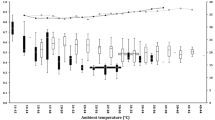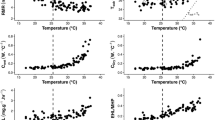Abstract
The reddish-gray mouse lemur (Microcebus griseorufus) is one of only a few small mammals inhabiting the spiny forest of southwestern Madagascar. In this study we investigated the physiological adjustments which allow these small primates to persist under the challenging climatic conditions of their habitat. To this end we measured energy expenditure (metabolic rate) and body temperature of 24 naturally acclimatized mouse lemurs, kept in outdoor enclosures, during different seasons (summer, winter, and the transition period between the two seasons). Mouse lemurs displayed two main physiological strategies to compensate seasonal and diurnal fluctuations of ambient temperature. On the one hand, individuals entered hypometabolism with decreasing ambient temperature (T a) during the transition period and winter, enabling them to save up to 21 % energy per day (92 % per hour) compared with the normal resting metabolic rate at comparable T a. On the other hand, euthermic mouse lemurs also showed physiological adjustments to seasonality when resting: the lower critical temperature of the thermoneutral zone decreased from summer to winter by 7.5 °C, which allowed mouse lemurs to keep energy demands constant despite colder T as during winter. In addition, the basal metabolic rate was substantially lowered prior to the winter period, which facilitated accumulation of fat reserves. The combination of physiological modifications during euthermia in addition to hypometabolism, which can be individually adjusted according to external parameters and respective body condition, is important as it allows M. griseorufus to cope with the environmental variability of an energetically challenging habitat.





Similar content being viewed by others
References
Atsalis S (1999) Seasonal fluctuations in body fat and activity levels in a rain-forest species of mouse lemur, Microcebus rufus. Int J Primatol 20:883–910
Bennett AF, Nagy KA (1977) Energy expenditure in free ranging lizards. Ecology 58:697–700
Bonaccorso FJ, McNab BK (1997) Plasticity of energetics in blossom bats (Pteropodidae): impact on distribution. J Mammal 78:1073–1088
Corp N, Gorman ML, Speakman JR (1997) Seasonal variation in the resting metabolic rate of male wood mice Apodemus sylvaticus from two contrasting habitats 15 km apart. J Comp Physiol B167:229–239
Dausmann KH, Glos J, Ganzhorn JU, Heldmaier G (2005) Hibernation in a tropical primate. Nature 429:825–826
Dausmann KH, Glos J, Heldmaier G (2009) Energetics of tropical hibernation. J Comp Physiol B 179:345–357
Fietz J, Ganzhorn JU (1999) Feeding ecology of the hibernating primate Cheirogaleus medius: how does it get so fat? Oecologia 121:157–164
Geiser F (2004) Metabolic rate and body temperature reduction during hibernation and daily torpor. Annu Rev Physiol 66:239–274
Geiser F, Körtner G (1995) Effect of photoperiod and ambient temperature on activity patterns and body weight cycles of mountain pygmy-possums, Burramys parvus (Marsupialia). J Zool Lond 235:311–322
Geiser F, Holloway J, Körtner G (2007) Thermal biology, torpor and behaviour in sugar gliders: a laboratory-field comparison. J Comp Physiol B 177:495–501
Génin F (2008) Life in unpredictable environments: first investigation of the natural history of Microcebus griseorufus. Int J Primatol 29:303–321
Génin F, Nibbelink M, Galand M, Perret M, Ambid L (2003) Brown fat and nonshivering thermogenesis in the gray mouse lemur (Microcebus murinus). Am J Physiol 284:R811–R818
Hannah L, Dave R, Lowry PP, Andelman S, Andrianarisata M, Andriamaro L, Cameron A, Hijmans R, Kremen C, MacKinnon J, Randrianasolo HH, Andriambololonera S, Razafimpahanana A, Randriamahazo H, Randrianarisoa J, Razafinjatovo P, Raxworthy C, Schatz GE, Tadross M, Wilmee L (2008) Climate change adaptation for conservation in Madagascar. Biol Letts 4:590–594
Hart JS, Heroux O (1955) Exercise and temperature regulation in lemmings and rabbits. Can J Biochem Phys 33:428–435
Heldmaier G (1989) Seasonal acclimatization of energy requirements in mammals: functional significance of body weight control, hypothermia, torpor and hibernation. In: Wieser W, Gnaiger E (eds) Energy transformation in cells and organisms. Georg Thieme, Stuttgart, pp 130–139
Heldmaier G, Steinlechner S (1981) Seasonal control of energy requirements for thermoregulation in the Djungarian hamster (Phodopus sungorus), living in natural photoperiod. J Comp Physiol B142:429–437
Heldmaier G, Ortmann S, Elvert R (2004) Natural hypometabolism during hibernation and daily torpor in mammals. Respir Physiol Neurobi 141:317–329
Holloway JC, Geiser F (2001) Seasonal changes in the thermoregulation of the marsupial sugar glider, Petaurus breviceps. J Comp Physiol B 171:643–650
Kappeler PM (1997) Intrasexual selection and testis size in strepsirhine primates. Behav Ecol 8:10–19
Kobbe S, Dausmann KH (2009) Hibernation in Malagasy mouse lemurs as a strategy to counter environmental challenge. Naturwissenschaften 10:1221–1227
Kobbe S, Ganzhorn JU, Dausmann KH (2011) Extreme individual flexibility of heterothermy in free-ranging Malagasy mouse lemurs (Microcebus griseorufus). J Comp Physiol B 181:165–173
Körtner G, Geiser F (2000) The temporal organization of daily torpor and hibernation: circadian and circannual rhythms. Chronobiol Int 17:103–128
Lovegrove BG, Génin F (2008) Torpor and hibernation in a basal placental mammal, the lesser hedgehog tenrec Echinops telfairi. J Comp Physiol B 178:691–698
Maddocks TA, Geiser F (2000) Seasonal variations in thermal energetics of Australian silvereyes (Zosterops lateralis). J Zool 252:327–333
Nicoll ME (1986) Diel variation in body temperature in Tenrec ecaudatus during seasonal hypothermia. J Mammal 67:759–762
Nowack J, Mzilikazi K, Dausmann KH (2010) Torpor on demand: heterothermy in non-lemur primate Galago moholi. PLoS One 5:e10797
Nowack J, Wippich M, Mzilikazi K, Dausmann KH (2013) Surviving the cold, dry period in Africa: behavioral adjustments as an alternative to heterothermy in the African lesser bushbaby (Galago moholi). Int J Primatol 34:49–64
Pörtner HO, Farrell AP (2008) Physiology and climate change. Science 322:690–692
Ruf T, Heldmaier G (1992) The impact of daily torpor on energy requirements in the Djungarian hamster, Phodopus sungorus. Physiol Zool 65:994–1010
Schmid J (1999) Sex-specific differences in activity patterns and fattening in the gray mouse lemur (Microcebus murinus) in Madagascar. J Mammal 80:749–757
Schmid J (2000) Daily torpor in the gray mouse lemur (Microcebus murinus) in Madagascar: energetic consequences and biological significance. Oecologia 123:175–183
Schmid J, Speakman JR (2000) Daily energy expenditure of the grey mouse lemur (Microcebus murinus): a small primate that uses torpor. J Comp Physiol B 170:633–641
Schmid J, Ruf T, Heldmaier G (2000) Metabolism and temperature regulation during daily torpor in the smallest primate, the pygmy mouse lemur (Microcebus myoxinus) in Madagascar. J Comp Physiol B 170:59–68
Scholander PF, Walters V, Hock R, Irving L (1950) Body insulation of some arctic and tropical mammals and birds. Biol Bull 99:225–236
Speakman JR (2008) The physiological costs of reproduction in small mammals. Philos Trans R Soc Lond B Biol Sci B363:375–398
Stawski C, Geiser F (2010) Seasonality of torpor patterns and physiological variables of a free-ranging subtropical bat. J Exp Biol 213:393–399
Terrien J, Perret M, Aujard F (2011) Behavioral thermoregulation in mammals: a review. Front Biosci 16:1428–1444
Wang LCH (1989) Ecological, physiological, and biochemical aspects of torpor in mammals and birds. In: Wang LCH (ed) Advances in comparative and environmental physiology. Springer Verlag, Berlin, Heidelberg, pp 361–401
Warnecke L, Withers PC, Schleucher E, Maloney SK (2007) Body temperature variation of free-ranging and captive southern brown bandicoots Isoodon obesulus (Marsupialia: Peramelidae). J Therm Biol 32:72–77
Withers PC (2001) Design, calibration and calculation for flow-through respirometry systems. Aust J Zool 49:445–461
Acknowledgements
This study was carried out under the “Accord de Collaboration” between Madagascar National Parks (MNP), the University of Antananarivo and the University of Hamburg and all procedures comply with the current laws of Madagascar. We acknowledge the authorization and support of this study by the Ministère de l’Environnement des Forêts, MNP and the University of Antananarivo. We thank D. Rakotomalala and J. Rakotomalala (MNP Toliara) for their hospitality and support while working in Tsimanampetsotsa. P. Giertz, J. Hammer and J. Ganzhorn supported this field project in numerous ways. The study was supported by the DFG (Ga 342/14-1, 15-1), BMZ/GTZ, WWF Germany and WWF Madagascar.
Author information
Authors and Affiliations
Corresponding author
Additional information
Communicated by G. Heldmaier.
Rights and permissions
About this article
Cite this article
Kobbe, S., Nowack, J. & Dausmann, K.H. Torpor is not the only option: seasonal variations of the thermoneutral zone in a small primate. J Comp Physiol B 184, 789–797 (2014). https://doi.org/10.1007/s00360-014-0834-z
Received:
Revised:
Accepted:
Published:
Issue Date:
DOI: https://doi.org/10.1007/s00360-014-0834-z




